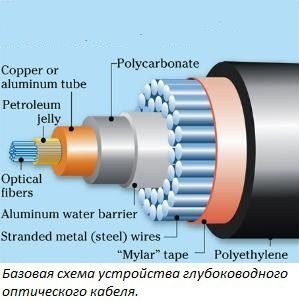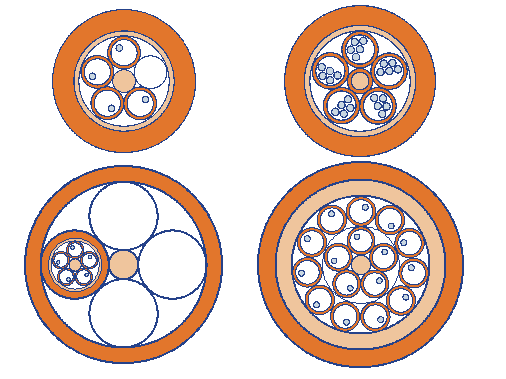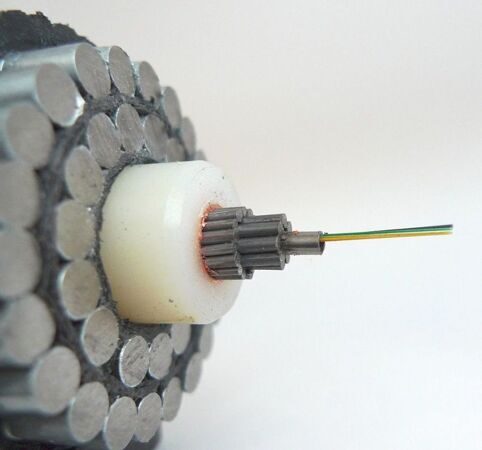Submarine cable construction
SUBMARINE CABLE
Submarine or submersible cables are specialized power cables that can operate at a depth of 5-8 kilometers.
It is understood that submarine cables must have the following basic characteristics:
• Durability
• Waterproofing
• Maintain the enormous pressure of the water mass
• Have sufficient strength for installation and operation
• Should maintain functionality under mechanical stress (cable tension during operation / installation, for example)

The operating part of the cable has no significant difference from conventional cables. The main distinction lies in the deepwater cable protection around the operating part of to maximize its lifespan while submersed deep underwater. This is evident in the schematic drawing displayed above.
Polyethylene - a traditional external insulation layer of the cable. This material is an excellent choice for direct contact with the water, as it has the following properties:
Water resistant, it is non reactive with any alkali solutions, neutral, acidic and basic salts, organic, inorganic acids such as concentrated sulfuric acid.
In fact, Oceans contain all naturally occuring elements, and water is a universal solvent. Using such a common material in the chemical industry as polyethylene, is a logical solution for underwater power cables as it eliminates the neccesity for engineer maintenance by preventing components of the cable to reacting with water, thus avoiding its destruction under the influence of the environment. Polyethylene was used as an insulating material in the course of laying the first intercontinental telephone lines in the mid 20th century.
However, due to the porous structure of polyethylene, it can not provide complete waterproofing of the cable. Therefore, an extra layer of water protection is added:
Mylar - a synthetic material based on polyethylene. It has the following properties:
It does not give off an odor, is non-reactive, high barrier properties (including to many corrosive environments), tear (10 times stronger than polyethylene), wear and shock resistance. The mylar material(or in the USSR - Lavsan) is widely used in industrial settings including packaging textiles and the space industry. However, the use of this material is limited to multilayer films because of shrinkage during heat sealing.
Following the layer of Mylar film, reinforcement cables of varying strength and capacities can be found, dependent on the characteristics of the desired product and its purpose. Powerful steel braided cables are often used to provide sufficient stiffness and strength, as well as to counter the aggressive external mechanical influences. For example, according to some reports, EMI cables can lure sharks that gnaw through cables. Also, at greater depths, cables laid without entrenchment can catch fishing boats with their gear. To protect against such influences, a pre-galvanized reinforced steel cable sheath is used. Amplification of the cable can occur in several layers. The main concern of the manufacturer in the course of its operation is to ensure even pressure when winding steel wire. Double-wrapping the wire provides reinforcement in different directions. If pressure balance is not maintained during the course of this operation, the cable may spontaneously twisted into a spiral, forming a loop.
As a result of these measures the mass of a kilometer of cable can be up to several tons. "Why not use light and durable aluminum to counteract this issue?" - is a question asked by many. Although aluminium is resistant to oxidation, however when in contact with seawater, an intense reaction can occur with the hydroxide ions, which will have a detrimental effect on the functionality of the cable. For this reason; steel is used instead of aluminium.
An aluminum water barrier or a layer alumopolyethylene used as another layer of waterproofing and cable shielding. Alumopolyethylene is a combination of aluminum foil and polyethylene film interconnected by an adhesive layer. Bonding can either be one-sided and double-sided. The wide design of the alumopolyethylene makes it look almost invisible. The film thickness can vary between manufacturers. As a rough example, Russian manufacturers create the film with a single sided thickness of 0.15-0.2 mm.
A layer of polycarbonate is again used for reinforcement.
This material is lightweight, durable and resistant to pressure and shock. It is widely used in everyday products, such as bicycle and motorcycle helmets, as well as the material used in the manufacture of lenses, CDs and lighting products. The polycarbonate sheet option is used in construction as the light-transmitting material. It has a high coefficient of thermal expansion and its application is widely found in the production of cables.
A Copper or aluminum tube encases the cable core and provides it with shielding. A secondary set of copper tubes containing optical fibers fit inside this design. Depending on the design of the cable, the amount of tubes can vary and they can be interwoven in different ways. The following four examples show the organization of the core cable:

Laying fiber in copper tubes which are filled with hydrophobic thixotropic gel and metallic structural elements used for the organization of the intermediate generators - devices performing reshaping of the optical pulse that propagates along the fiber as it undergoes distortion.
The overall structure of the submersible power cable should look like this:




